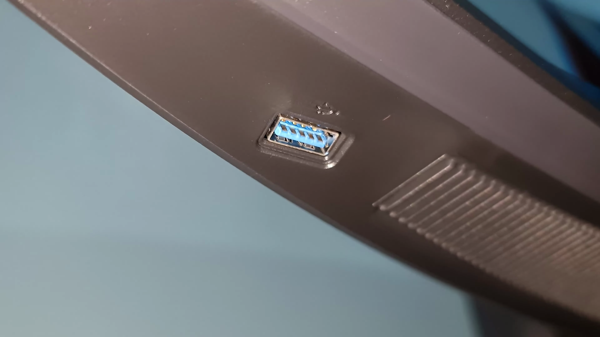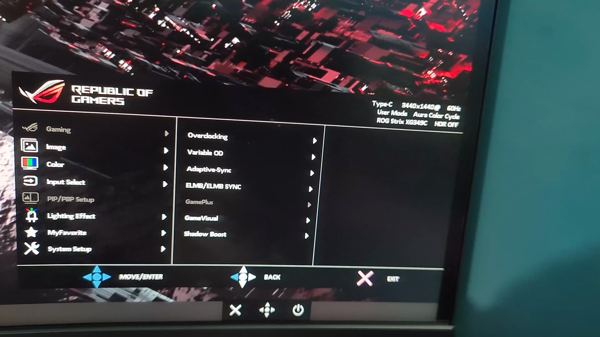Note: As an Amazon Associate I earn from qualifying purchases.
My review of the ASUS ROG Strix 34’ UWQHD 180Hz Gaming Monitor (XG349C) - (2024)
Introduction
For some weeks now I have been testing out the ASUS ROG Strix XG349C monitor for both gaming and work. I work long hours in front of a pc every day, hence finding a good monitor is crucial for me. My requirements are a high resolution, high refresh rate, and versatile connectivity options, all of which this model delivers on.
Specifications
| Property | Value | Property | Value |
|---|---|---|---|
| Screen Size | 34 Inches | Display Resolution Maximum | 3440 x 1440 Pixels |
| Brand | ASUS | Special Feature | Height Adjustment, Blue Light Filter, Swivel Adjustment, Flicker-Free |
| Refresh Rate | 180 Hz |
Photos
Click on photos to enlarge them:
Prices
Check prices of the ASUS ROG Strix 34’ Gaming Monitor Black on:
Immersive Gaming Performance

When it comes to an immersive gaming experience, few monitors can match the prowess of the ASUS ROG Strix XG349C. This behemoth of a display has been my go-to for both intense gaming sessions and casual movie watching, and here’s why:
Ultra-wide Fast IPS panel: The 34-inch screen with a 3440 x 1440 resolution is nothing short of breathtaking, especially with that ultra-wide aspect ratio giving me an expansive field of view in games.
Buttery-smooth performance: The combination of a 180Hz refresh rate and a 1ms response time makes every movement silky smooth, which is a huge advantage in fast-paced games.
ELMB Sync: Being able to utilize motion blur reduction alongside G-SYNC compatibility means game visuals are crisp, with no annoying ghosting or tearing.
However, perfection is elusive, and the ROG Strix XG349C is not without its shortcomings. While the brightness and color performance are impressive, there are moments when the HDR can look too saturated, taking away from the realism. Also, while the integrated KVM switch is a nifty feature for those of us juggling between multiple machines, it can be a bit cumbersome to operate manually.
Using it is a dream when you’re deep into a gaming session or lost in the latest blockbuster, but interacting with the menus and some of the OSD controls can be less intuitive than I’d like, sometimes requiring multiple button inputs to perform a simple task.
Despite these niggles, the monitor’s strengths do overshadow its weaknesses. If you’re a serious gamer who values a premium visual experience, or a professional needing wide screen real estate, the ROG Strix XG349C strikes a solid balance. It’s got the muscle for competitive gaming and the finesse for when you need to appreciate the finer details in visual content.
The 180Hz refresh rate is a game-changer, particularly in genres that demand twitch reflexes. I’ve found that shooters and high-speed racing games benefit immensely from the monitor’s ability to keep up with the chaos. Sure, not everyone will need the overclocking potential, but it’s great having that extra headroom.
And while the ASUS Fast IPS technology ensures that image clarity is maintained across high frame rates, I’ve noticed the contrast could be better, a common critique for those used to VA panels. Transitioning to an IPS display can be a bit jarring at first, but once your eyes adjust, the vibrancy and consistency of colors become apparent.
In essence, my time with the ASUS ROG Strix XG349C has been mostly positive, with the impressive screen real estate and super-fluid visuals making for an incredibly immersive experience. The drawbacks are there, sure, but they’re far from deal-breakers. If your budget allows and your setup is craving a monitor upgrade, this ASUS offering is definitely worth considering.
Visuals and Color Excellence

The ASUS ROG Strix XG349C stands out to me primarily for its visuals and color accuracy which is vital for both gaming and professional use. I’ve found the 34-inch UWQHD (3440 x 1440) HDR curved display to be more than just a spec – it’s a window to a vibrant and detailed world, whether I’m immersed in intense gaming sessions or enjoying high-resolution movies. With the DisplayHDR 400 certification, the contrast and color performance is genuinely striking, delivering a wide color range that brings visuals to life with startling realism.
One major positive is ASUS’s Fast IPS technology, which ensures a 1ms response time (GTG); something that’s essential for fast-paced games. The lack of smearing or motion blur gives me an edge when reaction times are crucial.
However, it’s not all perfect. While the 180Hz refresh rate is fantastic for smooth gameplay, I sometimes miss the depth that a VA panel would offer. IPS panels are known for their color accuracy and viewing angles, but they can’t match the deep blacks provided by VA panels. Yet, after some initial doubts, I must admit the IPS panel has grown on me, and the trade-off is worth the exceptional color performance.
Here are the bullet points that capture the visual strengths and shortcomings of this display:
Pros:
Color Vibrancy: Images are rich and lively; this level of vibrancy is a visual treat.
Sharp Detail: The UWQHD resolution means games and movies are incredibly sharp and clear.
Fast Response: The 1ms response rate keeps everything looking crisp, with no blur.
Cons:
Contrast: As expected from an IPS, the blacks aren’t as deep as I’ve seen on VA panels.
Price: Top-tier visuals come with a relatively high price tag.
Despite the minor gripes about contrast, the benefits of this ASUS monitor overwhelmingly tip the scale in its favor. While VA panels have their place, once you’ve experienced this level of detail and color vibrancy, it’s hard to go back. The ASUS ROG Strix XG349C is, therefore, a successful stride in monitor technology, particularly for those who prioritize color accuracy and vibrancy over deeper blacks.
Lastly, I appreciate that the monitor isn’t just about gaming. It’s versatile enough for professional creative work, where color fidelity can be just as critical. From my personal use, whether I’m editing photos or simply basking in the lush visuals of a graphically-demanding game, the ROG Strix XG349C consistently delivers outstanding performance that justifies its position in a higher-tier market segment.
Connectivity and Integration

One of the standout features of the ASUS ROG Strix XG349C is its impressive array of connectivity options. From personal experience, navigating the connections on a monitor can be a hassle, often leading to a cluttered desk. This monitor, however, streamlines your setup by offering a comprehensive hub that caters to various input needs.
Here are my key observations in terms of connectivity and integration:
USB Type-C hub: The integration of USB Type-C is a game-changer. It allows for video transmission through a DisplayPort signal and serves as a USB hub for connecting devices. This means fewer cables and a cleaner workspace, which is always a plus in my book.
Rich port selection: The inclusion of DisplayPort 1.4, HDMI (v2.0), and additional USB 3.0 ports means I have plenty of options when it comes to connecting my peripherals. It’s convenient to have alternatives that support various devices with different needs.
KVM switch: A KVM (Keyboard, Video, Mouse) switch is embedded, enabling control over multiple computers from this single monitor. Yet, it’s important to mention that the KVM switch is manual. While I appreciate the functionality it adds, I can’t help but wish for an automatic switching feature.
Here’s a quick list of what stood out to me regarding the connectivity:
Pros:
USB Type-C for DisplayPort signal and peripheral connectivity
Abundance of input options including HDMI and DisplayPort
KVM functionality minimizing the need for multiple displays
Cons:
The manual KVM switch may be cumbersome for some users
Limited USB ports on the hub; I could use a couple more for added flexibility
The G-SYNC compatibility has delivered a seamless, tear-free gaming experience by enabling Variable Refresh Rate by default, a feature that plays well with my NVIDIA graphics card. The addition of a USB Type-C port that also charges devices just adds to the convenience. A reversible USB Type-C connector means I no longer fumble around trying to plug in my devices.
While these features are impressive, I have noted that the KVM switch, while a welcome feature, requires manual toggling between devices. This can interrupt the flow of work or play and can be a bit inconvenient for someone who frequently switches between multiple machines.
Although the HDR technology offers a great range of luminance, I’ve noticed that the color saturation can sometimes feel a bit overdone, especially with HDR content. This might not be a deal-breaker, but it’s something to be mindful of when tweaking your settings for the perfect visual experience.
Overall, the connectivity and ability to integrate multiple devices with my ASUS ROG Strix XG349C has been a substantial benefit, contributing to a more efficient and streamlined experience. I believe these features notably enhance the overall user experience, despite some minor drawbacks in the form of manual KVM switching and a less-than-ideal number of USB ports.
Ergonomics and Aesthetics

Evaluating the ASUS ROG Strix XG349C gaming monitor from an ergonomic and aesthetic standpoint, some features immediately stand out. It boasts a sleek, futuristic design that is iconically associated with the ROG product line, blending stylish accents with practical functionality. However, aesthetics are only one facet of this product; ergonomics play a crucial role in daily use, particularly for those who spend extended hours at their screen, whether for work or gaming.
Here’s a quick rundown of the ergonomics and aesthetics:
Pros:
The stand is robust, offering height, tilt, and swivel adjustments, making it simple to find the optimal viewing angle.
The 34-inch curved design not only looks impressive but also envelops the field of view for increased immersion.
The ultra-wide screen allows for a multi-application view, increasing productivity and enhancing gaming sessions.
Cons:
Limited USB ports might hinder users who rely on multiple peripherals.
Manual KVM switch can be cumbersome if frequently switching between devices.
I was immediately drawn to the stand’s flexibility, allowing for height adjustment and swivel, which reduced the neck strain I often experienced with less versatile setups. The monitor’s ability to pivot is a subtle feature that I found to be a significant benefit when sharing content with someone sitting beside me.
In my experience, the curved aspect of the screen took some getting used to. Initially, I thought it might be a gimmick, but it certainly adds to the immersive feel during intense gaming sessions, and I’ve noticed less eye strain when working for long periods, which is an ergonomic win in my book.
Visually, the monitor is a beauty with its sleek lines and gaming-centric design accents. Thin bezels give it a modern touch that complements any desk setup, and the Aura Sync lighting is a nice touch that adds a personal flair, even if it is more aesthetic than functional.
One downside is the limited number of USB ports. As someone who connects a multitude of devices, it’s a drawback to depend on an additional USB hub, which adds to desk clutter. Also, while the KVM manual switch is helpful for a multi-device setup, an auto-switching function would greatly smooth out the user experience.
To conclude, the ASUS ROG Strix XG349C is a solid performer that doesn’t skimp on aesthetics or ergonomics. While it excels in providing a comfortable and engaging visual experience, some practical aspects, like port availability and KVM functionality, leave a bit to be desired. Nevertheless, the balance it strikes between a striking design and ergonomic adjustability makes it an attractive choice for gamers and professionals alike.





